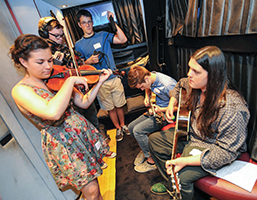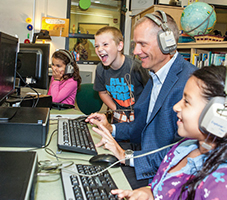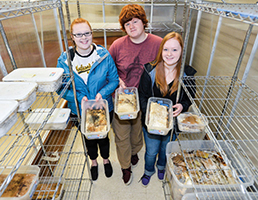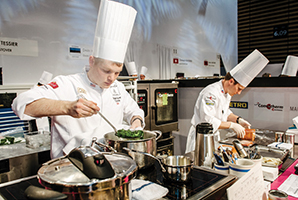
Cultivating Creative Schools
An arts-centric approach in Vancouver, Wash.,
sparks a ‘different kind of mind’
By Steven Webb and Tom Hagley Jr./School Administrator, December 2015
“Good design is a renaissance attitude that combines technology, cognitive science, human need and beauty to produce something that the world didn’t know it was missing.”
— Paola Antonelli,
curator of architecture and design, Museum of Modern Art
As pressure on public schools to generate high achievement scores continues to build, educators across the U.S. are troubled by the narrow focus on test prep and the dearth of creative and joyful learning taking place in too many classrooms.
We share their concerns and believe that supporting robust arts education for all students is essential to producing future-ready graduates.

|
Vancouver high school students compose, record and produce a music video on board the John Lennon Educational Tour Bus. (Photo courtesy of Vancouver Public Schools)
|
Arts are integral to the curriculum in Vancouver, Wash., Public Schools. Increasingly, our district is responding to external change forces by engaging students in more arts-centric learning experiences — ideating, creating, iterating and performing — as fundamental to their education. Giving young people the opportunity to select options that meet their diverse needs and interests also is a core value, as evident in our offering of nearly two-dozen schools or programs of choice. These pathways enable students to discover and develop their abilities and talents with curiosity and passion.

|
Superintendent Steven Webb engages in educational gaming with students at Eisenhower Elementary School. (Photo courtesy of Vancouver Public Schools)
|
Influencing our work are well-known authors and thought leaders, such as Daniel Pink. In
A Whole New Mind: Moving from the Information Age to the Conceptual Age, Pink contends, “The future belongs to a very different kind of person with a very different kind of mind.”
He identifies six essential qualities necessary for people to thrive in what he calls the “creative economy” — design, story, symphony, empathy, play and meaning. In his book
Creative Schools: The Grassroots Revolution That’s Transforming Education, Sir Kenneth Robinson names eight core competencies. They are curiosity, creativity, criticism, communication, collaboration, compassion, composure and citizenship. (See
Q&A with Robinson)
Regardless of the labels, consensus is emerging: The work world of tomorrow demands a broader set of aptitudes, skills and dispositions.
Replicating Practices
So how do we ensure every graduate is future-ready? We create arts-centric learning experiences that nurture the student outcomes identified by Pink and Robinson. By deconstructing artistic “thinking and doing,” we can replicate those practices more pervasively as a central learning construct in our schools. Design thinking, technology integration, maker spaces, project-based learning and authentic assessment are vital to what we want in future-ready Vancouver graduates who can think creatively and critically and apply their knowledge to solve complex problems in a rapidly changing world.

|
| High School students in Vancouver, Wash., show mushroom-growing compost they made from reclaimed cardboard waste. (Photo courtesy of Vancouver Public Schools) |
To illustrate this vision, we share four compelling stories of student success.
» Students market and communicate designs in competition.
The iPrize competition challenged students at Vancouver iTech Preparatory to design a product and marketing campaign and pitch it to a judging panel composed of professionals from the local community.
In a school where project-based learning flourishes and design thinking is encouraged, the 14- and 15-year-olds generated an array of ideas, including portable housing, phone cases with built-in wireless ear buds, medical devices and a plastic bit for horses that is gentler on the animal than metal bits. A student with a predilection for solving Rubik’s Cubes designed a first-place, six-by-six cube that allows for faster game play and is less likely to break.
Of course, creativity thrives in a collaborative environment. Engineers from Smith-Root, a manufacturer of fishing technology, helped students refine their prototypes and perfect their presentations. English teacher Ines Kuna immersed the students in the principles of classical rhetoric to help the budding entrepreneurs speak with credibility and conviction.
When the spotlight came on, the nine finalists were ready to go with PowerPoint presentations, videos and more to sway the judges. Several students now hope to bring their products to market.
Says Kuna, “I always have high expectations for the students, and they always blow me away, every single time.”
 |
| Skylar Stover’s hands-on learning in culinary arts at Fort Vancouver High School landed him in an international gastronomy competition with other young chefs. (Photo by Meg Smith/Ment'or) |
» Curiosity mushrooms into collaboration, taking learning to a higher level.
“It was just a little side project that led to this big thing,” says Kasandra Wielenbeck, a senior in the Architecture, Construction and Environmental Services, or ACES, magnet program at Hudson’s Bay High School in Vancouver.
The little side project: Using mushroom mycelia to reclaim cardboard waste, produce edible mushrooms and create compost.
The big thing was a national win in the annual Samsung Solve for Tomorrow contest, which incentivizes schools to engage students in science, technology, engineering and math. The honor came with a $120,000 prize for the school and sponsored trips to New York City and Washington, D.C.
Wielenbeck and ACES senior Brittney Hauff and junior Cedric Hitzeman, working with veteran horticulture teacher Steve Lorenz, impressed judges with their approach to recycling cardboard. Sorted and sterilized cardboard waste is inoculated with the mycelia of pearl oyster mushrooms. It then sits in the school’s mycology lab for about six months as the mycelia take root and grow mushrooms the students hope eventually to sell. The leftover cardboard waste is remediated further into compost that also can be sold.
Students plan to focus next on growing other mushroom varieties in a medium-scale operation. They envision the possibility of every school in Vancouver housing a one-acre recycling facility.
» Symphonic creativity crescendos in a music video.
On a warm August day at the height of summer break, seven high school students came together to compose, perform and create an original, professional music video. The creativity and talent came from the students. The opportunity came from their school, Vancouver School of Arts and Academics, and the visiting crew of the John Lennon Educational Tour Bus.
The tour bus, supported by a nonprofit, brings music education to students throughout the country. By providing access to state-of-the-art technology, the crew of the mobile recording studio is able to offer a unique and purposeful learning experience that merges art with technology. With guidance from the crew, students wrote lyrics and composed songs, ran through their sets, and revised their music.
“It was a new experience,” said student Emily Bryan. “I love improvising with other people. I love seeing what it creates, being spontaneous to create music.”
Two of the students worked as videographers and captured the music sessions, solos and additional background footage at various locations around the school. Later, they edited the entire day’s audio and video in the tour bus’ editing suite.
The tangible outcome of the day was a captivating, professional music video. More importantly for these seven students, learning became personal. Their passion and creativity gave this educational experience a true voice.
» Culinary journey brings meaning and composure.
Theory, knowledge and skills are great attributes in the culinary world. When it’s time to eat, though, what matters is presentation, smell and taste. If you want to know how well someone can cook, ask him or her to make something.
Young culinary artists learn best in a real-world, hands-on environment such as the Culinary Arts Program at Fort Vancouver High School. For one recent graduate, a solid foundation of learning by doing led to a meteoric rise in the culinary world.
Skylar Stover arrived at Fort Vancouver as a freshman with an individualized education program, or IEP. In the Culinary Arts Program, he gained the structure that helped him shed his IEP and hone his work ethic. While learning the basics and valuable techniques, he also picked up catering jobs and worked at a student-run cafe.
In the five years after graduation, Stover cooked at an up-and-coming Seattle restaurant, followed by a stint at the three-Michelin-star French Laundry. He catapulted into culinary history at the famed Bocuse d’Or competition. As the commis, or chef’s assistant, for Team USA, Stover helped claim a second-place finish, the highest showing ever for an American team and the highest placement by any non-European country in Bocuse d’Or history.
Future Ready
We can prepare our young people by integrating arts-centric learning experiences as a central construct of education in America. Students must master rigorous literacy, math and science standards, but the work world of tomorrow also expects our graduates to be creative, critical thinkers who respond to new challenges with agility. At this intersection are inspiration and innovation, empowering our young people to thrive in a globally connected and interdependent economy and community.
Ken Robinson addresses that imperative in
Creative Schools: “As I see it, the aims of education are to enable students to understand the world around them and the talents within them so that they can become fulfilled individuals and active, compassionate citizens.”
In Vancouver Public Schools, we couldn’t agree more.
Steve Webb is superintendent of Vancouver Public Schools in Vancouver, Wash. E-mail:
Steven.Webb@vansd.org. Twitter:
@SuptVPS.
Tom Hagley is the district’s chief of staff. Contributing to this article were
Pat Nuzzo and
Amanda Richter.
Additional Resources
To learn more about the four success stories of creative schools and programs of choice in Vancouver, Wash., visit the following sites: